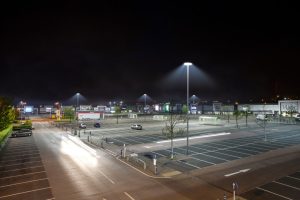Proper lighting in car parks is essential to ensure visibility, reduce accidents, prevent crime, and create an enabling environment. Parking lot lighting provides drivers’ and pedestrians safety and comfort.
Learn the importance of parking lot lighting and its main lighting design considerations.
Parking lot lighting improves safety. Well-lit parking spaces provide good visibility, allowing drivers to safely navigate and maneuver their vehicles. Proper lighting helps drivers identify obstacles, pedestrians, and other vehicles, reducing the risk of accidents, collisions, and property damage. It also helps identify potential hazards such as potholes, curbs, or uneven surfaces, minimizing the chance of injury.
car park lighting is important for the safety of car parks. Bright lights create a sense of security, making people feel more comfortable and confident when parking their cars. Well-lit areas deter criminal activity such as theft, vandalism, and robbery. In addition, proper lighting allows surveillance cameras to capture clear images, which helps spot any suspicious activity and enhances overall security measures.
There are factors to consider when designing car park lighting. One of the key considerations is uniformity. Uniform lighting provides uniform illumination of the entire parking lot, minimizing dark spots or under-lit areas. It eliminates potential hiding places for criminals and improves visibility for drivers and pedestrians.

The color temperature of the lamps is an essential factor. The selection of color temperature depends on the purpose of the car park and the environment. A warmer color temperature creates a more comfortable atmosphere, while a cooler color temperature provides better visibility and may improve the perception of safety.
Energy efficiency is also an essential factor. Using energy efficient lighting solutions such as LED (light emitting diode) technology can help reduce energy consumption and lower maintenance costs. LEDs are known for their durability, longevity, and low power consumption compared to traditional lighting technologies such as incandescent or fluorescent lamps.
In addition, lighting controls and sensors can be incorporated into the design to optimize energy consumption. Motion sensors can detect movement and turn on the lights only when needed, reducing energy wastage during periods of little or no activity. Dimming controls can also be implemented, further improving energy efficiency.
Proper maintenance of parking lights is essential for optimum performance and longevity. Regular inspection, cleaning, and replacing defective lamps or fixtures are necessary to maintain good lighting. Timely maintenance also helps address potential lighting issues immediately, preventing accidents and providing safe parking for users.
Summary
Parking lot lighting is vital for safety and comfort. Proper lighting improves visibility, reduces accidents, deters criminal activity, and creates a favorable environment for drivers and pedestrians. Design considerations such as uniformity, color temperature, energy efficiency, and maintenance are critical in achieving optimal lighting solutions. By prioritizing and implementing proper lighting in parking lots, create safer parking spaces for everyone.
























+ There are no comments
Add yours